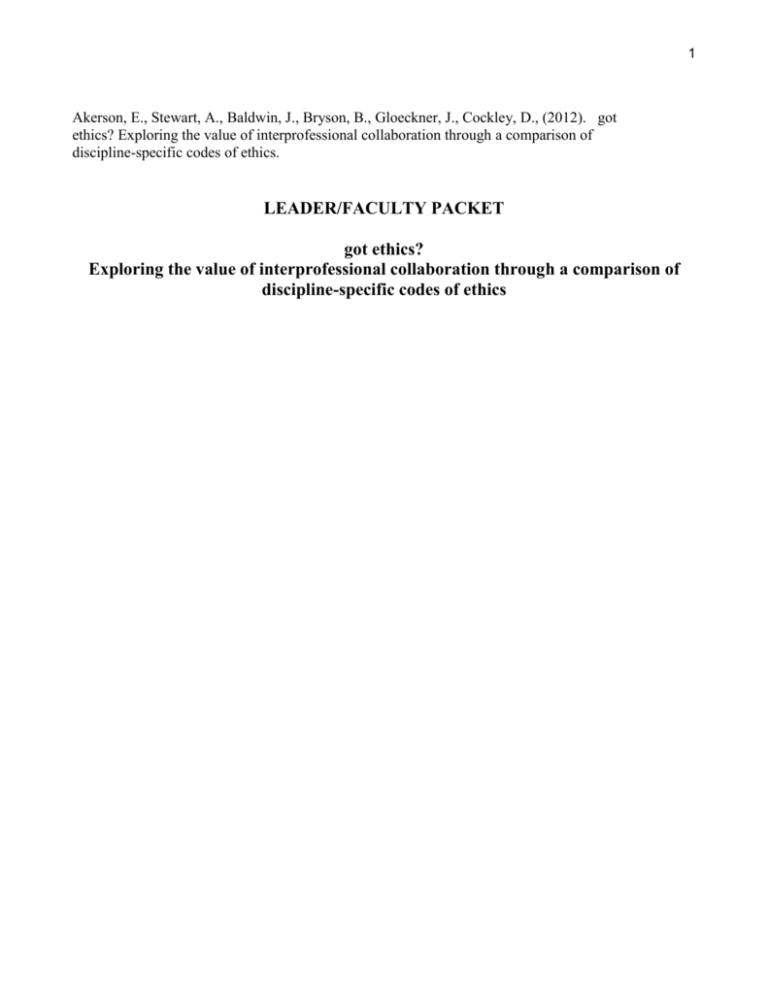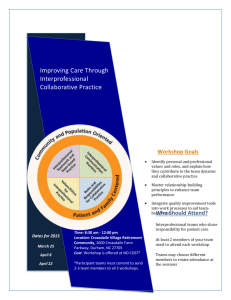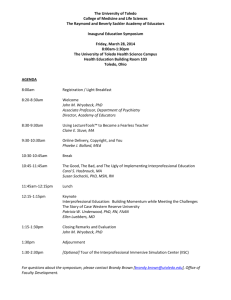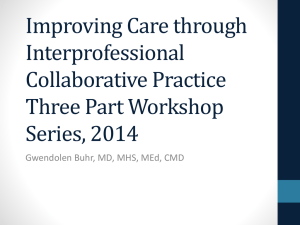Faculty Instructions Got Ethics Resources
advertisement

1 Akerson, E., Stewart, A., Baldwin, J., Bryson, B., Gloeckner, J., Cockley, D., (2012). got ethics? Exploring the value of interprofessional collaboration through a comparison of discipline-specific codes of ethics. LEADER/FACULTY PACKET got ethics? Exploring the value of interprofessional collaboration through a comparison of discipline-specific codes of ethics 2 got ethics? Exploring the value of interprofessional collaboration through a comparison of disciplinespecific codes of ethics Leader/Faculty Overview of the Module got ethics? Rationale Quality health care requires that health and human service professionals are well-informed about the contributions of their own and other health professionals. Ethics is a shared, relevant concern among health and human service disciplines and is an ideal vehicle for students from different fields to learn about one another’s disciplines and to participate in interprofessional discussions and problem-solving (Interprofessional Education Collaborative, 2011; World Health Organization, 2010). This session is relevant to a number of the general and specific core competencies named in the Core Competencies for Interprofessional Collaborative Practice: Report of an Expert Panel, including: Work with individuals of other professions to maintain a climate of mutual respect and shared values. Respect the unique cultures, values, roles/responsibilities, and expertise of other health professions. Listen actively, and encourage ideas and opinions of other team members. Develop consensus on the ethical principles to guide all aspects of patient care and team work. Reflect on individual and team performance for individual, as well as team, performance improvement. The session can be used at any time in a course sequence and may be especially useful as an introductory session. Session Objectives Students completing this session will have the opportunity to: • Engage in respectful discussion with other health and human service students from the same and different disciplines. • Develop an understanding of commonalities and differences in the ethical principles in health and human services professions. Target Audience This exercise is designed for students (undergraduate and graduate students) in health and human services. The session may also be adapted for use as an in-service activity for practicing professionals. Instructional Method The session uses experiential and didactic methods. The session consists of activities for small and large group interaction and facilitated discussions, with corresponding worksheets to guide and document student participation. Session Format (Time required: 1 hour and 10 minutes to 1 hour and 45 minutes) The got ethics? session has four parts: 1. Interprofessional introductions (15 to 20 minutes) 2. Discipline Huddle (15 to 30 minutes) 3. Interprofessional Ethics Grid (30 to 45 minutes) 3 4. got ethics? Evaluation (10 minutes) Students are placed in small groups (4 to 6 students) representing diverse health and human service disciplines. It is preferred that the session is conducted with leaders/faculty representing at least two different disciplines. Leader/Faculty Preparation (Prior to session) The session leaders are encouraged review the entire packet and modify the session activities to be most useful given the composition of their class and their unique learning objectives. It is recommended that the leaders complete the students required readings and prep work. Leaders may consult the Recommended Reading and Web Resource List for Leader/Faculty to identify additional readings or resources. Two recent publications provide an important context and framework for interprofessional education and practice and it is important for faculty to be familiar with them. The Core competencies for interprofessional collaborative practice: Report of an expert panel published in 2011 by the Interprofessional Education Collaborative and the World Health Organization’s 2010 publication titled Framework for action on interprofessional education and collaborative practice should be reviewed prior to class. Student Preparation (Prior to session) Required reading There are three required readings to complete prior to attending the session. The first one, Code of Ethics Online, is a repository for many professional codes of ethics in health and human services professions. Students are to use a copy of their discipline-specific code of ethics, obtained here or through their discipline-specific professional organization. For the second reading, students are to review the glossary to help foster clear communication in their discussions and to introduce them to new or less familiar terms. The third one provides an interprofessional perspective on ethical decision-making in healthcare teams with a case example. (Required Reading List for Students and Recommended Reading List for Student are in Appendix A.) 1. Code of Ethics Online is http://ethics.iit.edu/ecodes/ethics-area/28 This website is a repository for many professional codes of ethics in health and human services professions. Students are to use a copy of their discipline-specific code of ethics to complete a handout prior to class. 2. King, Nancy M.P., (2005) “Glossary of Basic Ethical Concepts in Health Care and Research.” In The Social Medicine Reader, 2nd Edition, edited by G. Henderson, S Estroff, L. Churchill, N. King, J Oberlander and R. Strauss, pp. 161 – 168. Durham, NC: Duke University Press. 3. Clark, P. G., Cott, C., & Drinka, T.J.K. (2007). Theory and practice in interprofessional ethics: A framework for understanding ethical issues in healthcare teams. Journal of Interprofessional Care, 21(6), 591-603. Required preparation Students are to complete a portion of the Interprofessional Ethics Grid handout prior to class. 4 List of Material in got ethics? Module Leader/Faculty Materials got ethics? Leader/Faculty Packet including: Leader/Faculty Overview of the Module Interprofessional Introduction Leader/Faculty Instruction Handout Discipline Huddle Leader/Faculty Instruction Handout Interprofessional Ethics Grid Leader/Faculty Instruction Handout Leader/Faculty got ethics? Evaluation Form Instruction Handout Recommended Reading and Web Resource List for Leader/Faculty Handout Student Materials Interprofessional Introduction Student Handout Interprofessional Ethics Grid Student Handout Student got ethics? Evaluation Form Required Reading List for Students (Must complete two readings prior to session) Recommended Reading and Web Resource List for Students Appendix A Readings and Resource Lists contains: Recommended Reading and Web Resource List for Leader/Faculty Required Reading List for Students (Must complete two readings prior to session) Recommended Reading and Web Resource List for Students Appendix B Student Activity Handouts contains: Interprofessional Introduction Student Handout Interprofessional Ethics Grid Student Handout Student got ethics? Evaluation Form Reflective Comments The authors believe it is important to create a core interprofessional team of committed leaders/faculty who agree to be present together at all sessions as it enhances the learning for students. The faculty members interact with the content in ways that model interprofessional collaborative practice. The core competencies for interprofessional collaborative practice apply to faculty members as they teach an interprofessional case based course collaboratively. When new faculty members join the faculty team, it is helpful if the new faculty member can mentor with their colleagues for one session, before being the sole representative for their health profession. This exercise can be used with a small group of 6 students representing at least 2 disciplines or with large group of over 100 students. With large groups, it is important to separate them into small groups of 6 – 8 students, with at least two disciplines represented in each small group. With large groups of students, the learning experience is enhanced if a cohort of upper level students are trained and supervised as interprofessional small group facilitators and assigned to each group. Faculty members circulate through the room and are resource persons for the small groups. Beginning in fall 2011, we collected specific data on the student evaluation of Interprofessional Ethics Grid exercise. In fall 2011, 96 students participated in the exercise and over 97% rated the experience as helpful or very helpful. In spring 2012, 79 students participated and 98.5% rated the experience as helpful or very helpful. The faculty report that the exercise is very valuable to their students and sets a 5 context for interprofessional collaborative practice. It provides an opportunity to reflect on disciplinary depth, collaborative practice, and "knowledge of one's own role and those of other professions, to appropriately assess and address the health needs of patients and populations served." (IPEC, 2011) 6 got ethics? Exploring the value of interprofessional collaboration through a comparison of disciplinespecific codes of ethics The Interprofessional Introduction Leader/Faculty Handout Interprofessional introductions (15 to 20 minutes) Rationale Students typically come to the IPC process with little knowledge or experience of the interprofessional collaboration (IPC) approach. In addition, they come to IPC having selected a specific health or human service major and developing identity. This can pose a challenge for their readiness for IPC, because they are unfamiliar with what IPC is and may also have limited knowledge of their own professional scope of practice. Purpose The purpose of the Interprofessional Introduction activity is for students to hear examples of professional identities that integrate professional and personal aspects in a respectful and reflective manner. The session leaders describe their own professional development/identity, integrating both discipline-specific and interprofessional aspects. Following the faculty introductions, the students introduce themselves to each other in their small groups. Objectives Students will have the opportunity to: • Engage in respectful discussion with other health and human service students from the same and different disciplines. • Develop an understanding of commonalities and differences in the scope of practice and service delivery setting across their own and other health and human services professions. Materials Needed The Interprofessional Introduction Leader/Faculty Handout The Interprofessional Introduction Student Handout Activities 1. Welcome. The session leaders welcome the students and note the diverse disciplines represented in the class and, in a conversational manner, share the rationale and purpose for the session (See got ethics? Rationale, Recommended Readings and Resources). Leaders may also reference information from the readings and codes of ethics to emphasize the importance of IPC. 2. Interprofessional Introductions by leaders. Leaders introduce themselves to the class. Be sure to address the following elements in your introduction: 1. 2. 3. 4. Name, degree and/or license Major field of study and/or work setting A person, event or situation that influenced your career choice A personal value or characteristic that you believe helps you be well suited to your career 5. An interprofessional experience that illustrates why you value IPC 7 6. A surprising fact about you (be sure to model appropriate disclosure and comment about this to the students) 3. Interprofessional Introductions by students. Students introduce themselves to their small group by sharing their responses to the Interprofessional Introduction Student Handout (In Appendix B). Students will each share the following. 1. 2. 3. 4. 5. 6. Your name Major field of study and/or practica setting A person, event or situation that influenced career choice A personal value or characteristic that you believe helps you be well suited to your career An interprofessional experience that illustrates why you value IPC A surprising fact about you 4. Follow-up large group discussion by Leader/Faculty. The session leaders solicit comments from the group regarding the similarities and differences across and within the students, as well as discovering surprising facts about the students. The sharing of surprising facts helps illustrate that we are more than our professional identities. 8 got ethics? Exploring the value of interprofessional collaboration through a comparison of disciplinespecific codes of ethics The Discipline Huddle Leader/Faculty Handout The Discipline Huddle (15-30 minutes, depending upon group size and number of leaders) Rationale Understandably, student’s thinking about their profession is narrowed to their interests, as well as exposure to their profession from the larger culture. For example, social work students may think of social workers as only involved in child welfare instead of seeing them instrumental in policy, regulatory, or social justice work; nursing students may see their profession practicing exclusively in a hospital, rather than operating in public or community health. Purpose The purpose of the Discipline Huddle is to provide students an opportunity to give voice to the depth and breadth of their discipline-specific professional understanding before they engage in interprofessional collaboration team activities. Objectives Students will have the opportunity to: • Engage in respectful discussion with other health and human service students from the same disciplines. • Develop an understanding of commonalities and differences in the scope of practice and service delivery setting across their own health and human services professions. Materials Needed The Discipline Huddle Leader/Faculty Handout Activities 1. Select leaders. Assign a leader/faculty identified with discipline to facilitate each Discipline Huddle discussion. For example, if the group has nursing, social work, and pre-professional health students, you would need a leader in each of these disciplines to facilitate discussion. This allows a level of expertise regarding the profession and will later serve to debunk student assumptions or misconceptions. If this is not possible on a continuing basis you may rotate the available leaders or invite guest professionals from the respective disciplines to participate. 2. Introduce the Discipline Huddle activity. Explain the activity to the class using information from the rationale and readings. 3. Discipline Huddle. Break into discipline-specific groups and begin facilitated discussion using questions shown below: a) b) c) d) What do you imagine (whatever the discipline is) does and in what settings? Types of patients/clients/consumers would be addressed? What types of issues do they bring? What do you think is unique about your chosen discipline /profession? What do you think your discipline brings to interprofessional collaboration? 9 4. Follow up. Move the students back into their interprofessional teams for a brief large group discussion. Leaders/Faculty solicits observations from the students about their respective group observations, including some of the discipline myths experienced and professional challenges. 10 got ethics? Exploring the value of interprofessional collaboration through a comparison of disciplinespecific codes of ethics The Interprofessional Ethics Grid Leader/Faculty Handout The Interprofessional Ethics Grid (30 to 45 minutes.) Rationale Quality health care requires that health and human service professionals are well-informed about the contributions of their own and other health professionals. Ethics is a shared, relevant concern among health and human service disciplines and is an ideal vehicle for students from different fields to learn about one another’s disciplines and to participate in interprofessional discussions and problem-solving (Interprofessional Education Collaborative, 2011; World Health Organization, 2010). Purpose The purpose of the Interprofessional Ethics Grid exercise is to familiarize students with their own code of ethics and to determine commonalities and differences in their professional code and that of other professions. Objectives Students will have the opportunity to: • Engage in respectful discussion with other health and human service students from the same and different disciplines. • Develop an understanding of commonalities and differences in the ethical principles in health and human services professions. In class they seek to discover similarities and differences within the various codes on their interprofessional teams completing column two. Materials Needed The Interprofessional Ethics Grid Leader/Faculty Handout The Interprofessional Ethics Grid Student Handout (Appendix B) Code of Ethics (each student should bring a copy of their professions code of ethics to the session) Activities This activity has two parts. The first part is completed prior to the session. Students come prepared to discuss their Code of Ethics/Professional Ethical Statement with members of their interprofessional team and bring a copy of their code of ethics to the session. 1. Prior to the session. Students are to complete the readings and review their professional ethical codes then fill-in the first column of the Interprofessional Ethics Grid Student Handout. 2. During session explain the Interprofessional Ethics Grid exercise. Instruct students to compare their grid among team members from other disciplines. As they discuss the grid, tell them to complete the last column of the grid by comparing their code with another discipline’s code. Discuss all the disciplines represented but select just one discipline for comparison in the column. If they finish the grid, students are to complete the final section of the handout regarding how their ideas about their 11 discipline, interprofessional collaboration, and ethics may have changed. Students should share these observations at their small group, if time permits. Otherwise, the responses may be used by the leader/faculty to note growth and understanding of the material. 3. Circulate. Visit the small group and offer clarifying comments and questions to support engaged dialogue. Alert the groups when they have 10 minutes left to complete the grid and remaining portions of the handout. 4. Follow up. Facilitate comments from the large group about this experience. What did they learn about their own and other health and human service professions? Pose the questions from the last portion of the handout to discover what they initially believed about their own discipline, interprofessional collaboration, and ethics and what they now understand differently. With large groups a hand held microphone is useful. Supplemental questions: Ask how each member might contribute to an interprofessional team and in what ways do you believe you need other professions to work competently and ethically? What might be the challenges to interprofessional collaboration? What are the benefits to the client? Provider? System of care? How might interprofessional collaboration impact ethical dilemma faced in practice? 12 got ethics? Exploring the value of interprofessional collaboration through a comparison of disciplinespecific codes of ethics Leader/Faculty got ethics? Evaluation Form Handout got ethics? Evaluation Form (10 minutes) Rationale The evaluation is designed to promote reflection on individual contributions and group processes relevant to IPC core competencies, such as listening actively, and encouraging ideas and opinions of other team members and reflecting on individual and team performance and improvement. Purpose The purpose of the evaluation is to provide students an opportunity to reflect on their contribution to the success of the session and provide feedback about the relative value of each activity. Objectives Students will have the opportunity to: • Reflect on individual and group performance and improvement and provide feedback about the usefulness of each activity in the session. Materials Needed got ethics? Evaluation Form (Appendix B) Activities 1. Summarize and thank the students for their participation. Leader/Faculty offers comments and observations to the larger group noting the quality of their work and professional demeanor. Explain how the evaluation data will be used. 2. Distribute Evaluation form. Give the handout to each student and provide 10 minutes for them to complete. 3. Dismiss. 13 Appendix A Recommended Reading and Web Resource List for Leader/Faculty Required Reading List for Students Recommended Reading and Web Resource List for Students 14 got ethics? Exploring the value of interprofessional collaboration through a comparison of disciplinespecific codes of ethics Recommended Reading and Web Resource List for Leader/Faculty Beauchamp, T. and Childress, J. 2009 (6th ed.), Principles of Biomedical Ethics, Oxford, New York, PP. 1-56. *Code of Ethics Online is http://ethics.iit.edu/indexOfCodes.php?cat_id=31 This website repository for many professional codes of ethics in health and human services professions. *Clark, P.G, Cott, C., & Drinka, T.J.K. (2007) Theory and practice in interprofessional ethics: A framework for understanding ethical issues in health care teams Journal of Interprofessional Care, December 2007; 21(6): 591 – 603. Geva, G, Barsky, A., Westernoff, F. (2000) Developing a framework for diversity informed practice. In Interprofessional practice with diverse populations: cases in point. Esther Geva, Allan Barsky, andFern Westernoff, Eds., Westport, Connecticut: Auburn House. This is an excellent article that addresses the questions "What is interprofessional practice?", "Why interprofessional practice?", "How does interprofessional practice operate?", and "What are the challenges to interprofessional practice?" Hamric, A.B. (2002). Bridging the gap between ethics and clinical practice. Nursing Outlook, 50(5), 176-8. Hamric, A.B., & Delgado, S. (2009). Ethical Decision Making. In A.B. Hamric, J.A. Spross, & C.M. Hanson (Eds.), Advanced Practice Nursing: An Integrative Approach (4th ed., pp 315-346). St. Louis: Saunders Elsevier. Institute of Medicine (2003). Health professions education: A bridge to quality. Washington, DC: The National Academies Press. Interprofessional Education Collaborative Expert Panel. (2011). Core competencies for interprofessional collaborative practice: Report of an expert panel. Washington, D.C.: Interprofessional Education Collaborative. *King, Nancy M.P., (2005) “Glossary of Basic Ethical Concepts in Health Care and Research.” In The Social Medicine Reader, 2nd Edition, edited by G. Henderson, S Estroff, L. Churchill, N. King, J Oberlander and R. Strauss, pp. 161 – 168. Durham, NC: Duke University Press. *Required reading for students 15 Web Resources Code of Ethics Online http://ethics.iit.edu/ecodes/ethics-area/28 This website is a repository for many professional codes of ethics in health and human services professions. Students and faculty will certainly want a copy of their discipline-specific professional code of ethics as they guide practice, not only in the extreme circumstances that we encounter, but also to inform the everyday decisions that characterize our work with patients, clients, families, and communities. Interprofessional practice: harness the power of healthcare teams. Retrieved from http://www.youtube.com/watch?v=iLwFrMYttz4 This YouTube Video from The University of Queensland in Australia describes and discusses the roles of health and human service professionals in interprofessional practice teams. You may be able to click it and access the YouTube video directly but you may need to copy the URL for viewing. Interprofessional Teamwork. (2010). Retrieved from http://www.youtube.com/watch?v=Fh7tIr4Tl1o&feature=related This 18 1/2 minute YouTube Video was developed in 2010 by University of Leicester, University of Northampton, De MontFort University and Leicestershire, Northamptonshire and Rutland Workforce Development Confederation. It describes interprofessional roles and responsibilities and highlights examples from different settings that demonstrate the potential for optimizing health outcomes for individuals, families and communities. World Health Organization (2010). Framework for action on interprofessional education and collaborative practice. Geneva: WHO Press. Retrieved from: http://www.who.int/hrh/resources/framework_action/en/ 16 got ethics? Exploring the value of interprofessional collaboration through a comparison of disciplinespecific codes of ethics Required Readings for Students Code of Ethics Online http://ethics.iit.edu/ecodes/ethics-area/28 This website is a repository for many professional codes of ethics in health and human services professions. You will certainly want a copy of your professional code of ethics as they guide practice, not only in the extreme circumstances that come to mind, but also the everyday decisions that characterize our work with patients, clients, families and communities. You may need to contact your discipline-specific professional organization for a copy of your code of ethics if it is not available on this site. Clark, P.G, Cott, C., & Drinka, T.J.K. (2007) Theory and practice in interprofessional ethics: A framework for understanding ethical issues in health care teams Journal of Interprofessional Care, December 2007; 21(6): 591 – 603. King, Nancy M.P., (2005) “Glossary of Basic Ethical Concepts in Health Care and Research.” In The Social Medicine Reader, 2nd Edition, edited by G. Henderson, S Estroff, L. Churchill, N. King, J Oberlander and R. Strauss, pp. 161 – 168. Durham, NC: Duke University Press 17 got ethics? Exploring the value of interprofessional collaboration through a comparison of disciplinespecific codes of ethics Recommended Reading and Web Resource List for Students Beauchamp, T. and Childress, J.:2009 (6th ed.), Principles of Biomedical Ethics, Oxford, New York, PP. 1-56. Clark, P.G, Cott, C., & Drinka, T.J.K. (2007) Theory and practice in interprofessional ethics: A framework for understanding ethical issues in health care teams Journal of Interprofessional Care, December 2007; 21(6): 591 – 603. Geva, G, Barsky, A., Westernoff, F. (2000) Developing a framework for diversity informed practice. In Interprofessional practice with diverse populations: cases in point. Esther Geva, Allan Barsky, and Fern Westernoff, Eds., Westport, Connecticut: Auburn House. This is an excellent article that addresses the questions "What is interprofessional practice?", "Why interprofessional practice?", "How does interprofessional practice operate?", and "What are the challenges to interprofessional practice?" Hamric, A.B. (2002). Bridging the gap between ethics and clinical practice. Nursing Outlook, 50(5), 176-8. This article builds the case for the importance of the ongoing conversation of everyday ethical decision-making in clinical practice and discusses potential pitfalls. Hamric, A.B., & Delgado, S. (2009). Ethical Decision Making. In A.B. Hamric, J.A. Spross, & C.M. Hanson (Eds.), Advanced Practice Nursing: An Integrative Approach (4th ed., pp 315-346). St. Louis: Saunders Elsevier. Institute of Medicine (2003). Health professions education: A bridge to quality. Washington, DC: The National Academies Press. Interprofessional Education Collaborative Expert Panel. (2011). Core competencies for interprofessional collaborative practice: Report of an expert panel. Washington, D.C.: Interprofessional Education Collaborative. King, Nancy M.P., (2005) “Glossary of Basic Ethical Concepts in Health Care and Research.” In The Social Medicine Reader, 2nd Edition, edited by G. Henderson, S Estroff, L. Churchill, N. King, J Oberlander and R. Strauss, pp. 161 – 168. Durham, NC: Duke University Press. 18 WEB RESOURCES Code of Ethics Online http://ethics.iit.edu/ecodes/ethics-area/28 This website is a repository for many professional codes of ethics in health and human services professions. Students and faculty will certainly want a copy of their discipline-specific professional code of ethics as they guide practice, not only in the extreme circumstances that we encounter, but also to inform the everyday decisions that characterize our work with patients, clients, families, and communities. Interprofessional practice: harness the power of healthcare teams. Retrieved from http://www.youtube.com/watch?v=iLwFrMYttz4 This YouTube Video from The University of Queensland in Australia describes and discusses the roles of health and human service professionals in interprofessional practice teams. You may be able to click it and access the YouTube video directly but you may need to copy the URL for viewing. Interprofessional Teamwork. (2010). Retrieved from http://www.youtube.com/watch?v=Fh7tIr4Tl1o&feature=related This 18.5 minute YouTube Video was developed in 2010 by University of Leicester, University of Northhampton, De MontFort University and Leicestershire, Northamptonshire and Rutland Workforce Development Confederation. It describes interprofessional roles and responsibilities and highlights examples from different settings that demonstrate the potential for optimizing health outcomes for individuals, families and communities. World Health Organization (2010). Framework for action on interprofessional education and collaborative practice. Geneva: WHO Press. Retrieved from: http://www.who.int/hrh/resources/framework_action/en/ 19 Appendix B Interprofessional Introduction Student Handout Interprofessional Ethics Grid Student Handout Student got ethics? Evaluation Form 20 got ethics? Exploring the value of interprofessional collaboration through a comparison of disciplinespecific codes of ethics The Interprofessional Introduction Student Handout Welcome to got ethics? Interprofessional collaboration is an approach that “values the ability of professionals to work with colleagues of other professions in a climate of mutual respect and shared values and to respect the unique cultures, values, roles/responsibilities, and expertise of other health professions” (Interprofessional Education Collaborative, 2011). You have the opportunity to: • Engage in respectful discussion with other health and human service students from the same and different disciplines. • Develop an understanding of commonalities and differences in the scope of practice and service delivery setting across their own and other health and human services professions. Getting to know you and me! Introduce yourself to your small group. Listen and note similarities and differences in your roles and practice settings. Please share the following. 1. 2. 3. 4. 5. 6. Your name Major field of study and/or practica setting A person, event or situation that influenced career choice A personal value or characteristic that you believe helps you be well suited to your career An interprofessional experience that illustrates why you value IPC A surprising fact about you 21 got ethics? Exploring the value of interprofessional collaboration through a comparison of disciplinespecific codes of ethics The Interprofessional Ethics Grid Student Handout Directions: Complete the required readings for the session prior to doing this handout. Fill-in the first column of the grid by consulting your discipline-specific code of ethics. Bring the grid with the first column filled in and a copy of your professional code of ethics to the session. In class, share your responses with your small group. Select one of the disciplines represented to directly compare and fill in the second column. What are the key principles or concepts of each code of ethics? Your Professional Code of Ethics (Completed prior to class session) Another Professional Code of Ethics (Completed in class session with team members.) What is the primary duty to the patient, client, family or community? Your Professional Code of Ethics (Completed prior to class session) Another Professional Code of Ethics (Completed in class session with team members) 22 How does the code of ethics address collaboration? Your Professional Code of Ethics (Completed prior to class session) Another Professional Code of Ethics (Completed in class session with team members) How does the code address social justice? Culture/diversity? Autonomy? Your Professional Code of Ethics (Completed prior to class session) Another Professional Code of Ethics (Completed in class session with team members) Does the code of ethics seem to primarily address the patient/client/consumer, the provider or some other group? Does it seem to be created more to enforce standards or to protect the client or provider? 23 To be completed individually, after you fill in the other column of the interprofessional grid with a student from a different profession. WHAT I BELIEVED ABOUT: WHAT I NOW UNDERSTAND DIFFERENTLY ABOUT: My discipline My discipline Ethics Ethics Interprofessional Collaboration Interprofessional Collaboration 24 got ethics? Exploring the value of interprofessional collaboration through a comparison of disciplinespecific codes of ethics Student got ethics? Evaluation Form 1. Motivation for participation in session. How motivated were you to participate in this session? (Check) ☐Extremely motivated ☐Moderately motivated ☐Moderately unmotivated ☐Extremely unmotivated 2. How actively did you participate in today’s session? (Circle) ☐ Extremely active ☐ Moderately active ☐ Moderately inactive ☐ Extremely Inactive 3. Identify your discipline/profession. Briefly state three professional roles and/or responsibilities that you believe you/your discipline bring to interprofessional collaboration. Profession/discipline: ________________________________ a) b) c) How helpful were the following items toward advancing your understanding of your own and other disciplines, of interprofessional work, and codes of ethics? Interprofessional introductions Disciplinary huddle IPC Ethics Grid Reading and Codes of Ethics Very Not Helpful Helpful Helpful 4. Identify one thing, if any, that would have improved your learning this session. 5. Identify one thing you might have done to improve your learning? Extremely Not Helpful









